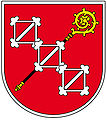Crook
| Crook in hieroglyphics | |||
|---|---|---|---|
heqa ḥq3 ruler's scepter |
|||
auet ˁwt shepherd's crook |
|||
The crook ( ancient Egyptian heqa, auet ruler's scepter, shepherd's crook , otherwise also abbot 's staff , lituus , baculum pastorale, bishop 's staff, pastoral staff , pastorale and pedum or virga ) has been an ancient Egyptian insignia since the Old Kingdom (2707–2216 BC). occupied and was adopted as a religious symbol of rule by many countries.
In the Christian tradition, the crook belongs to the pontificals and consists of a shaft and the curvature at its upper end . The bend consists mostly of gold-plated silver or copper and is often artistically designed; the approximately 1.5 meter long shaft is mostly made of wood. Sometimes a hanging cloth, the pannisellus, is attached at the level of the pommel .
Origin and history
Old Egypt
In ancient Egypt, the crook was the symbol of rule for various kings ( pharaohs ) and deities, for example Min , Osiris and the Horus child . It symbolized both rebirth and regeneration.
In the ancient Egyptian Book of the Dead , the crook or shepherd's staff belonged to the equipment of Osiris in his function as judge over the dead . With the shepherd's staff, Osiris had the power to decide about the entry into the hereafter and to help the Ba-soul to be reborn every day. In addition, the crook could be used as a tool for raising animals. Thus the ancient Egyptian crook formed the template that the bishop's staff lived on.
Further development

In the 4th century, Emperor Constantine gave the bishops permission through the privilegium fori to carry a staff similar to the staff of augurs as a symbol of spiritual and secular jurisdiction .
One of the earliest mentions is the pastoral staff given by the Archbishop of Canterbury to Abbot Theodore of Canterbury. The staff was first attested around the year 600 at the consecration of Saint Columban of Luxeuil . The actual crook became widely used, especially among church dignitaries in Spain and France in the 7th century , outside of the liturgy as a symbol of jurisdiction.
In Þingvellir on Iceland a tau-cross -like double-sided curled bishop's staff was found.
Ring and Staff - Investiture Controversy
The investiture controversy was shaped by the question of who was entitled to give prelates a ring and staff . In the Worms Concordat , Emperor Heinrich V accepted the Pope's claim to the right of investiture and renounced investiture with a ring and staff.
In return, Pope Calixt II admitted that the election of the German bishops and abbots should be negotiated in the presence of imperial deputies, but that the elected should be enfeoffed by the emperor through the scepter with the regalia associated with his spiritual office . While in the German part of the empire the regalia was to be awarded by the emperor before the consecration, in Italy and Burgundy the ring and staff were initially awarded, which practically lost the emperor's influence on the appointment of bishops.

Liturgical use
At the present time, wearing the crook in the liturgy of the Catholic Church is reserved for dignitaries with their own area of jurisdiction . These include in particular bishops , abbots and abbesses, and more rarely prelates .
The diocesan bishop carries the crosier in his own diocese. Outside of his diocese , the bishop may only wear the bishop's staff as a symbol of his pastoral office with the permission of the responsible Ordinary and only if he conducts a solemn service there. An auxiliary bishop generally has permission to hold the crosier in the diocese in which he works.
In the case of an episcopal ordination, the ordaining bishop carries the bishop when entering and, when a diocesan bishop is ordained, hands it over to the newly ordained bishop at the moment of the takeover of the diocese, who then carries it. When an auxiliary bishop is ordained, a new bishop's staff is presented to him, and when the bishop leaves, both the consecrated and the consecrated bishop carry a bishop's staff.
It used to be that the owner held the stick in his own territory in such a way that the curvature points outwards, and in "foreign" territory in such a way that the curvature points towards him. Auxiliary bishops always used the staff in the last-mentioned way due to the lack of authority of their own. This is still practiced in some places - for example in the Archdiocese of Paderborn - but it contradicts the renewed ceremonial for the bishops, which provides for the former form of use for all bishops (regardless of their jurisdiction at the place of the pontifical act).
If several bishops or clerics with the right of pontificals take part in a liturgical celebration, usually only the head of the celebration carries the pastoral staff. The Pope does not carry a crook, but a cross staff, the ferula .
The bishops of the Old Catholic , Orthodox and Anglican churches as well as some Lutheran churches outside Germany also use a bishop's staff.
heraldry
In heraldry , the crook is used in two ways:
- The staff can be used as a common figure on the escutcheon itself ; here it often designates the (former) domain of a bishop or prelate, e.g. B. a high pin . A well-known example is the Basel staff .
- Traditionally decorated miter and crosier (at Prince Bishops also the sword) and emblem trim the coat of arms of bishops and abbots. The use of the miter for timbring (coat of arms addition) of the coat of arms was in 1969 by Pope Paul VI. abolished. Since then, only the coats of arms of the "consecrated" abbots have the shepherd's staff behind the coat of arms. With the abbots mostly under the prelate's hat.
- The function of the wearer can be seen from the position of the scroll of the staff in portraits. If the snail points outwards (see picture) it is a bishop, if it points inwards it is an abbot. This is due to the fact that the bishop works outwards into the world and the abbot inwards into the church .
- A wide band with a ring can be attached to the pedum. This long loop, embroidered with church symbols and often with fringes, is called a pannisellus or sudariolum. This points to an abbot who earlier - unlike a bishop - did not wear pontifical gloves and therefore touched the staff with a handkerchief to protect it.
- The orientation of the snail is heraldic to the right, deviations must be reported.
- The crook in German heraldry
Coat of arms of the Bad Tölz-Wolfratshausen district
Coat of arms of the Biberach district
Bischberg coat of arms
Coat of arms of the city of Bützow
Coat of arms of the district of Cuxhaven : St. Nicholas with a silver crook, the curvature of which ends in a green four-petalled rose
Coat of arms of the Eichstätt district
Coat of arms with deer, Calw- Hirsau
Coat of arms of the district of Northwest Mecklenburg since 2011
Coat of arms of the Ostallgäu district
Coat of arms of the local community of Abtsteinach in the Odenwald
Coat of arms of the community of Benediktbeuern
Bodolz coat of arms with Pedum and Sudarium
Coat of arms of the local community Korweiler in the Hunsrück
Coat of arms of the municipality of Langwedel (Holstein)
Coat of arms of the municipality of Midlum in the district of Cuxhaven
Coat of arms of Ramsen (Palatinate) : crook and golden lance crossed
Coat of arms of the local community Schornsheim in the Alzey-Worms district
Coat of arms of Salem (Baden) with abbot's staff
Coat of arms of the municipality of Tholey in Saarland
Coat of arms of the diocese of Worms
Coat of arms of the Speinshart Abbey
Abbot coat of arms of Raymundus Regondi von Altenburg (1681–1715) according to an older custom
Heraldic ornament of an abbot (since 1969)
Crook, miter and sword as a shield ornament of the coat of arms of the Grand Masters of the Teutonic Order
Others
After the old French name for the bishop's staff ( la crosse ), the Indian game “Baggataway” (or “Tewaraathon”) was named in the 17th century and has been known by this name ever since: Lacrosse .
The saying “ living under the crook is good ” arose because the peasant subjects in the spiritual territories generally had more legal security and better living conditions; so there were no big landowners and no serfdom here . Also, there were more holidays there than in the secular areas.
literature
- Romuald Bauerreis: Abbot's staff and bishop's staff . In: Studies and communications on the history of the Benedictine order and its branches. Volume 68, 1957, ISSN 0303-4224 , pp. 215-226.
- Joseph Braun SJ: Crosier (and abbot) . In: Real Lexicon on German Art History . Volume 2: Bauer - Illumination. Druckmüller, Stuttgart 1948, p. 792.
- Friedrich Focke : scepter and crook. An investigation into the history of symbols. In: Wilhelm Tack (Hrsg.): Festgabe für Alois Fuchs for his 70th birthday on June 19, 1947. Schöningh, Paderborn 1950, pp. 337–387.
- Sandra Sandri: Har-Pa-Chered (Harpokrates). The genesis of an Egyptian god child (= Orientalia Lovaniensia analecta. Volume 151). Peeters, Leuven et al. a. 2006, ISBN 90-429-1761-X (also: Mainz, University, dissertation, 2004).
- Sybille Schneiders: Baculus pastoralis. Bishops and Abbot's Staffs of the 5th to 12th Centuries in Ireland and on the Continent: Typology and Chronology - Origin and Distribution - Ownership and Use . Freiburg i. Brsg. 2017 ( https://freidok.uni-freiburg.de/data/15776 ).
- Adolf Leopold von Wolfskron: The bishop's staff , its liturgical-symbolic meaning and gradual development of its shape. In: Communications of the KK Central Commission for the research and preservation of architectural monuments. Volume 2, No. 10, 1857, ZDB -ID 220003-x , pp. 256-262 .
- Mireille Bénéjeam-Lère: Les crosses des Evêques de Cahors au XIIIe siècle (iconographie et usages rituels) . In: Bulletin de la Société des études littéraires, scientifiques et artistiques du Lot. Volume 109, 1988, pp. 15-35, ISSN 0755-2483.
Web links
Individual evidence
- ↑ Sandra Sandri: Har-Pa-Chered (Harpokrates). 2006, p. 118.
- ↑ Simone Michel : The magical gems. On pictures and magic formulas on cut stones from antiquity and modern times (= studies from the Warburg house. 7). Akademie-Verlag, Berlin 2004, ISBN 3-05-003849-7 , p. 35.
- ^ Caeremoniale episcoporum, No. 59.
- ↑ Day of the Lord. Catholic weekly newspaper for the Archdiocese of Berlin and the dioceses of Dresden-Meißen, Erfurt, Görlitz and Magdeburg , No. 10 (March 11, 2018), p. 8.
- ↑ From Section 2, Paragraph 1 of the main statute of the district of Cuxhaven of December 11, 1996 in the version of the fourth amendment of February 24, 2004, read at http://www.landkreis-cuxhaven.de/media/custom/578_2895_1.PDF ? La = 1 & object = med% 7C578.2895.1 on May 9, 2009.





























